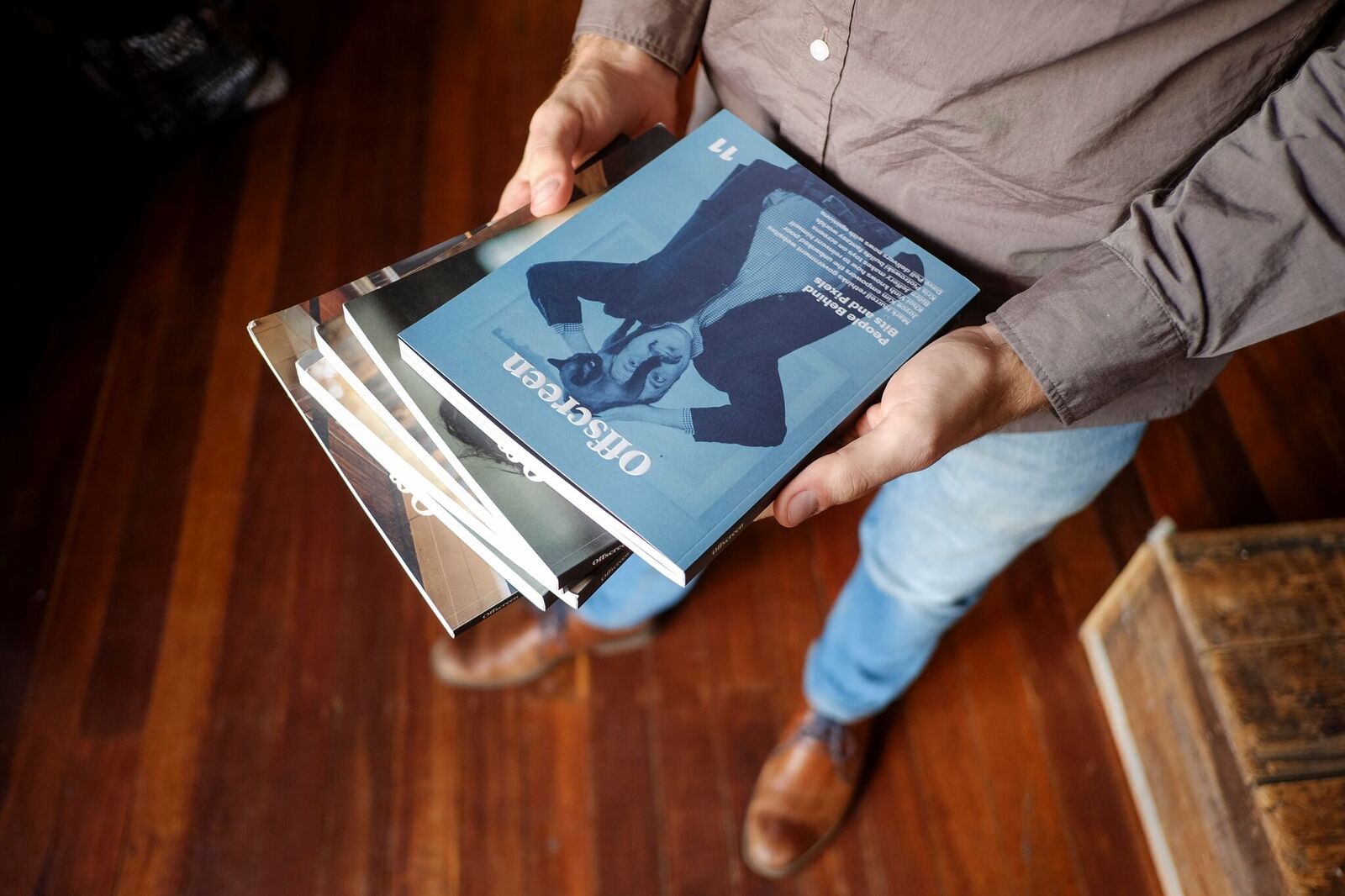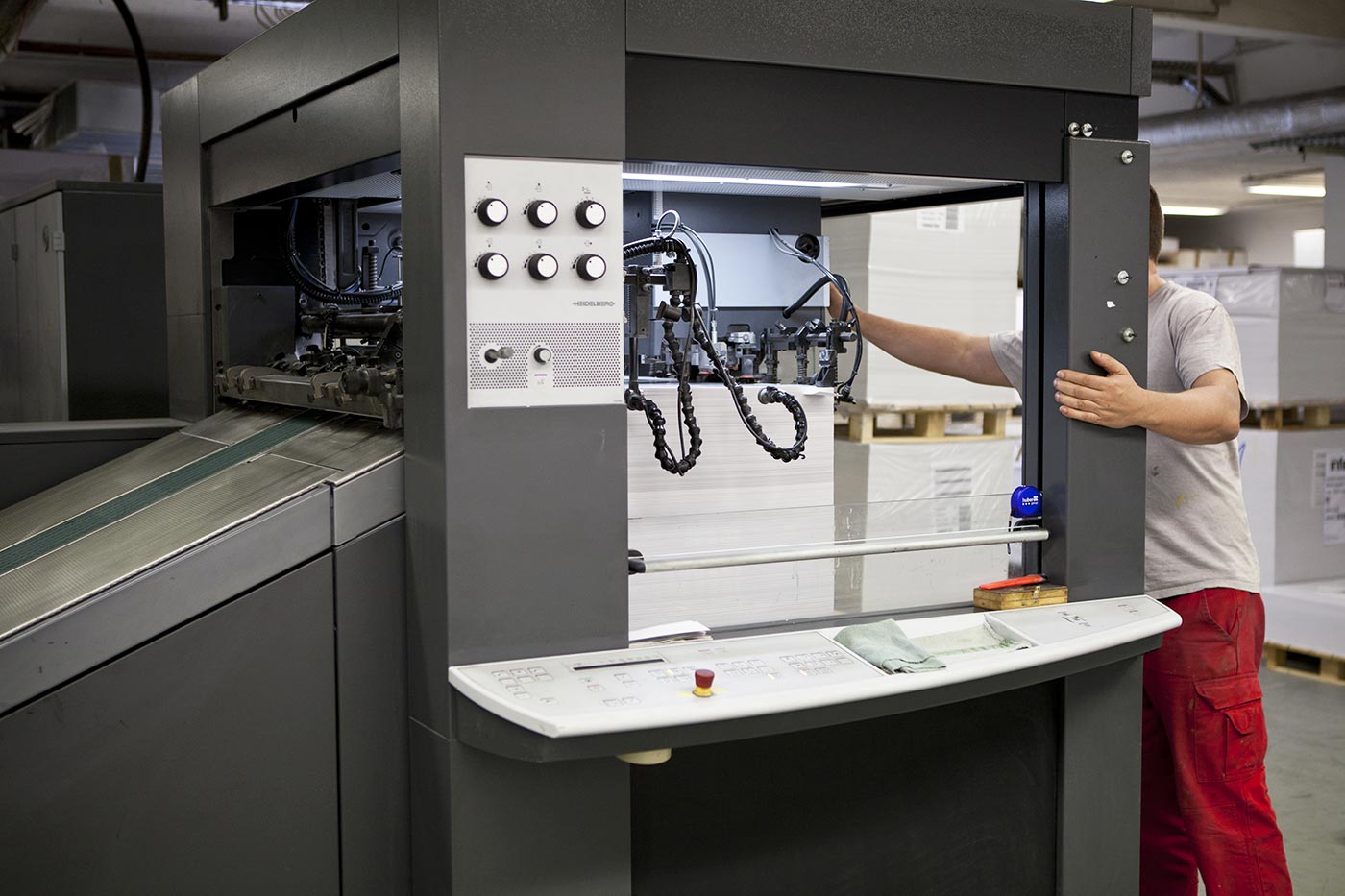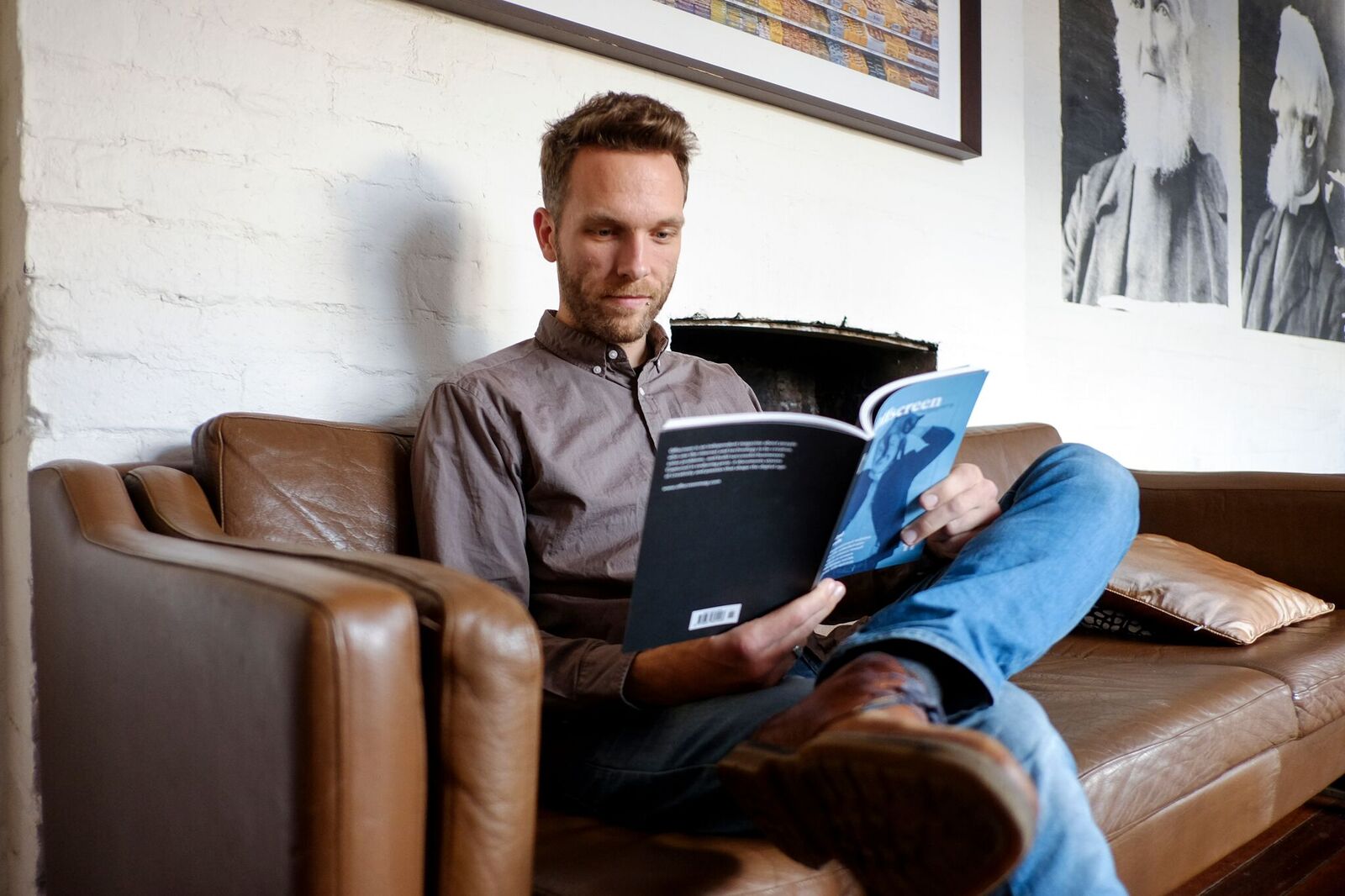Overcoming Publishing Hurdles to Build a $10k/mo Tech Magazine
Hello! What's your background, and what are you working on?
My name is Kai Brach. I'm the publisher/editor/founder of Offscreen Magazine, an independent print magazine and a weekly newsletter with a thoughtful, human-centered take on technology and the web.
The magazine is published three times a year out of Melbourne, Australia, but it's printed in and shipped from Berlin, Germany. The majority of the 5,000 copies are sold online, but there are also around 200 shops in capitals around the world that stock it.
Offscreen is a one-man operation and has been my full-time job ever since I launched it — now more than five years ago. I generate most of my income through the $20 cover price.

Kai holding some copies of the print magazine.
What motivated you to create a magazine?
Before launching Offscreen, I was designing websites for more than ten years, mostly as a freelancer. In early 2011 I felt really unfulfilled with the work I was doing. It may have been the type of clients, but it was also the fact that everything digital is so ephemeral. Months of creative work would simply disappear into the ether that is the internet, soon to be replaced by a new version number, an acquisition, or the latest design trend.
I decided to take a break, and traveled for a while, mostly catching up with other web folks. Meeting people and hearing the human stories behind products I had been using for years was quite eye-opening.
While I was traveling I also fell in love with printed magazines, and I explored the best magazine and book shops in the cities I visited. When I came back I decided that I wanted to combine the two: tell the human stories behind tech in a printed, more tangible format.
What went into getting the first issue out the door?
I essentially converted from web design to print design over the span of three months, teaching myself most of the skills by speaking to a lot of publishers, by watching tutorial videos, and by trial and error.
In late 2011 I launched a Kickstarter to raise $16,000 for my magazine idea. Unfortunately, it fell short, but because I had done so much legwork I decided to go ahead anyway using my own savings. I was lucky enough to find eight sponsors that at the time paid a small sponsor fee of just $400 each, which helped to cover at least some of the printing cost.
I decided to print the magazine in Germany, even though I'm based in Australia, because the Germans know a thing or two about printing, and because the cost is relatively low (especially compared to Australia). I was born in Germany and lived there half of my life, so communication wasn't an issue.
Another great benefit of moving production to Germany is that their postal service offers a simple, much more affordable pricing structure for media mailings. Sending a magazine like Offscreen to anywhere in the world only costs around EUR 3.50 in postage, versus four times that if I send it from Australia.
I created a pretty simple website to sell the magazine, and in February 2012 I launched Offscreen Issue 1 with a print run of 3,000. It didn't sell out overnight, but it sold relatively well in the first few weeks — well enough to commit to another issue shortly after.
And then another, and another.
It was just enough to live off in the first year, and I was lucky to have some personal savings. But as I was increasing sponsor fees and circulation and the subscriber count went up, it became a small, steady business with enough profit to make it sustainable and worthwhile.

Offscreen's printer, medialis, in Berlin.
How have you grown Offscreen and its subscriber base?
I always believed in Kevin Kelly's 1,000 True Fans theory — the idea that you only need around 1,000 loyal supporters in order to make what you do sustainable. 1,000 regular readers/customers seemed doable, and it's something I achieved about four issues or around fifteen months after launching Offscreen.
But let's be honest, you won't get rich from indie publishing. It's very different to building digital products in that the growth occurs very slowly and over several months/issues. Publishing anything in print requires passion, perseverance, and a bit of a financial runway. For indie magazines, making it sustainable is a big success. Being able to make a good living from it is our version of a unicorn.
The great thing about indie print mags is that they develop a very loyal and passionate following. Some people discover a publication they like at a friend's office, or in a bookstore, and become very attached to it. The physicality of print and that multisensory experience draws people in. In today's short-lived, ultra-fast world of bits and pixels, many of us rediscover the joy of holding a real book/magazine.
Since Offscreen is a one-man show, I don't have the luxury of doing much marketing. Most of the sales come from established readers/subscribers, through shops, or through my social media following and my mailing list.
I have pretty strong opinions about "doing the right thing" and conducting business in a thoughtful and ethical way, which means I rule out certain pushy ways of generating sales or leads that are very common in the "growth hacking" philosophy, e.g. newsletter sign-up popups, clickbaity listicles, and so on.
Something I regularly do (which you could put into the content marketing category, I guess) is share behind-the-scenes blog posts about the making of Offscreen. For example, I recently published…
- how I chose the new typeface of Offscreen,
- why I decided to change the binding of the magazine, and
- what my custom magazine subscription management system looks like.
Last year I wrote a giant post titled Indie Magonomics in which I shared everything I know about making the numbers add up.
In writing these posts I don't just want to help other fledgling publishers: I think many of my readers really enjoy hearing what goes into making a great little indie magazine, and it helps them understand why the magazine costs $20, not $5.
Can you talk about your pricing model, revenue, and expenses?
The magazine costs the reader $20, and that includes shipping to anywhere in the world. I spend about $7.50 of that on fulfilment (packaging, handling, and postage). The production cost sits at around $3 per copy (at a 5,000 copy print-run), which is mostly covered by sponsors. The editorial cost (writers, photographers, illustrators, proof-reader, etc.) varies from issue to issue, but sits at around $5,000-$7,500 per issue.
Based on the above figures you'd think that I make around $55,000 in pure profits per issue, but that's unfortunately not the case. Out of the 5,000 copies I print, only about half of them are sold at full price. The rest is sold to stockists, which keep 40-60%. I also give away a lot of free copies at tech/design conferences around the world: my marketing budget.
So while the revenue can sometimes be $200,000 or even more per year, the actual profit is more likely to be somewhere between $60,000 and $80,000 before tax.
Giving a simple, reliable number is made more difficult by my fairly infrequent publishing schedule (aiming for three issues per year). I had years in which I made more than $100,000 followed by a year in which I made half that. It really depends on the publishing dates. Also keep in mind that I live in one of the most expensive cities in the world. On that note, Berlin is a great place to launch a magazine because living expenses are still incredible low!
How important are regular subscribers to your business model?
Subscriptions are the backbone of any magazine and are therefore crucially important. Unfortunately, selling subscriptions of physical publications online (especially when they are released infrequently like Offscreen) is still really tricky.
For most indie publishers, subscriptions are usually just packs of the next X issues (usually covering a whole year) that are sold in advance. They don't renew automatically.
This means that readers have to come back a year later and renew their subscription manually. That's how Offscreen subscriptions worked, too, until recently. The problem is that every time it comes to the renewal a certain number of subscribers drop out because they simply forget.

I've tried to tackle this issue by building a new subscription system that works more like digital subscriptions: I now offer several tiers for subscribers — from standard readers ($20 per issue) to patrons ($50 per issue). Instead of paying a whole year upfront, I charge them every time a new issue is released. The subscriptions renew automatically until they cancel through their account or their credit card runs out (using Stripe, by the way).
I only launched this system a couple of months ago, and it's still too early to tell whether it yields better reader retention. I hope so, because developing the new back-end cost me around $15,000, which I was able to raise in a more recent fundraiser.
What does the future look like for Offscreen?
The last five years have been amazingly satisfying, but equally draining. I've definitely reached the limits of what one person can do with a magazine brand.
And to be honest, I'm happy staying small. I don't want to grow into a large media brand and expand into every possible format: podcasts, events, etc.
However, it would be nice to grow just enough to be able to hire a subeditor or an editorial assistant on a more permanent basis.
The recent relaunch and the introduction of the above subscription model aim at achieving that. I'd like to increase my subscriber number to an amount where I could afford hiring a part-time editor. Where that exact number lies is still to be determined, but 2,000-2,500 subscribers is what I currently aim for.
What are the biggest challenges you've faced? Obstacles you've overcome?
Gosh, where to begin?! Because I was a complete noob I made a lot of costly mistakes, from typos on the cover (which then had to be reprinted), to dealing with stockists who never paid their bills, to shipping boxes of issues that never arrived.
I've made lots of beginner mistakes, and that's why I'm so eager to share my experience — so that not everyone has to go through the same bumpy road to launching the first issues.
In practical terms, the biggest challenge is still organizing the content plan and finding contributors that are accessible, reliable, and a good fit. I'm interviewing lots of very busy people for the magazine, so finding time for long Skype chats and photoshoots is always a challenge.
Then of course there is the challenge of producing real, tangible products and shipping them around the world. Anyone dealing with the logistics involved will tell you that things frequently go wrong. You end up spending a lot of time apologizing to your customers for the inability of postal services to do their jobs properly.

More personally, the biggest challenge for me is to not run out of steam. Because it's just me, it's not always easy to keep up the level of enthusiasm, energy, and creativity required to publish new material. In publishing, "after one issue" always equates to "before the next issue". In other words, there is little time to appreciate the work you just put out.
I'm also struggling with separating leisure and work time, which means I'm more often than not in work mode. This doesn't necessarily lead to burnout, but it could lead to me not enjoying what I do, which in my eyes is almost worse. I'm reminded of something Jason Fried told me in our interview: despite all the talk about startups, it's actually easy to start something — it's much harder to keep it going.
What's your advice for indie publishers who are just starting out?
In terms of indie magazine publishing, I think a good start is my Indie Magonomics post. And here's a list I compiled with other helpful resources.
One more general piece of advice that I've also written about before is "to make it personal". Whatever you are creating, build your own ideals, values, and opinions right in. Don't pretend to be a big, faceless brand, but instead embrace your nimbleness and independence.
Forget professionalism. Create something unique that takes a stand and has a view. It may not appeal to everyone, but there will be a group (hopefully 1,000 true fans) that identify with what you have to say and throw their wholehearted support behind it, no matter what.
Where can we go to learn more?
Our latest issue is #16. You can buy a copy and subscribe at offscreenmag.com/buy. Every order counts and helps make future issues possible!
You can read more about me and our production process, find a stockist, or browse the blog. You can also follow me (@kaibrach) or @OffscreenMag on Twitter where I'm most active. Or just leave a comment below.

Not commenting yet because I need to go read the Indie Magonomics post!
...and I've read the Magonomics post and am floored - fantastic. Will be subscribing for sure. Go Aussie.
Very interested to see how I can apply the same principals for a directory-like site I'm putting together.